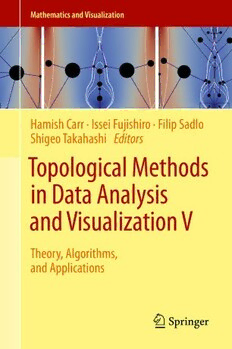Table Of ContentMathematics and Visualization
Hamish Carr · Issei Fujishiro · Filip Sadlo
Shigeo Takahashi Editors
Topological Methods
in Data Analysis
and Visualization V
Theory, Algorithms,
and Applications
Mathematics and Visualization
SeriesEditors
Hans-ChristianHege,Konrad-Zuse-ZentrumfürInformationstechnikBerlin(ZIB),
Berlin,Germany
David Hoffman, Department of Mathematics, Stanford University, Stanford, CA,
USA
ChristopherR.Johnson,ScientificComputingandImagingInstitute,SaltLake
City,UT,USA
KonradPolthier,AGMathematicalGeometryProcessing,FreieUniversitätBerlin,
Berlin,Germany
The series Mathematics and Visualization is intended to further the fruitful
relationship between mathematics and visualization. It covers applications of
visualization techniques in mathematics, as well as mathematical theory and
methodsthatareusedforvisualization.Inparticular,itemphasizesvisualizationin
geometry, topology, and dynamical systems; geometric algorithms; visualization
algorithms; visualization environments; computer aided geometric design;
computationalgeometry;imageprocessing;informationvisualization;andscientific
visualization.Threetypesofbookswillappearintheseries:researchmonographs,
graduatetextbooks,andconferenceproceedings.
Moreinformationaboutthisseriesathttp://www.springer.com/series/4562
Hamish Carr (cid:129) Issei Fujishiro (cid:129) Filip Sadlo (cid:129)
Shigeo Takahashi
Editors
Topological Methods in Data
Analysis and Visualization V
Theory, Algorithms, and Applications
Editors
HamishCarr IsseiFujishiro
UniversityofLeeds KeioUniversity
Leeds,UK Yokohama,Kanagawa,Japan
FilipSadlo ShigeoTakahashi
HeidelbergUniversity,IWR UniversityofAizu
Heidelberg,Germany Aizu-WakamatsuCity,Fukushima,Japan
ISSN1612-3786 ISSN2197-666X (electronic)
MathematicsandVisualization
ISBN978-3-030-43035-1 ISBN978-3-030-43036-8 (eBook)
https://doi.org/10.1007/978-3-030-43036-8
MathematicsSubjectClassification:76M24,53A45,62-07,62H35,65D18,65U05,68U10
©SpringerNatureSwitzerlandAG2020
Thisworkissubjecttocopyright.AllrightsarereservedbythePublisher,whetherthewholeorpartof
thematerialisconcerned,specificallytherightsoftranslation,reprinting,reuseofillustrations,recitation,
broadcasting,reproductiononmicrofilmsorinanyotherphysicalway,andtransmissionorinformation
storageandretrieval,electronicadaptation,computersoftware,orbysimilarordissimilarmethodology
nowknownorhereafterdeveloped.
Theuseofgeneraldescriptivenames,registerednames,trademarks,servicemarks,etc.inthispublication
doesnotimply,evenintheabsenceofaspecificstatement,thatsuchnamesareexemptfromtherelevant
protectivelawsandregulationsandthereforefreeforgeneraluse.
Thepublisher,theauthors,andtheeditorsaresafetoassumethattheadviceandinformationinthisbook
arebelievedtobetrueandaccurateatthedateofpublication.Neitherthepublishernortheauthorsor
theeditorsgiveawarranty,expressedorimplied,withrespecttothematerialcontainedhereinorforany
errorsoromissionsthatmayhavebeenmade.Thepublisherremainsneutralwithregardtojurisdictional
claimsinpublishedmapsandinstitutionalaffiliations.
ThisSpringerimprintispublishedbytheregisteredcompanySpringerNatureSwitzerlandAG.
Theregisteredcompanyaddressis:Gewerbestrasse11,6330Cham,Switzerland
Preface
Thirty years ago, the field of scientific visualization established the importance
of studying systematic methods for representing data on screen, in particular for
functionscomputedoverEuclideanspace.Astime haspassed,thedata sizeshave
increased to the point where it is no longer feasible to present all of the data
to a human interpreter, and scientific visualization has therefore depended ever
more heavily on analytic techniques to extract significant information for human
consideration.
One of the most successful approacheshas been the application of topological
analysis to data, and the past 30years have seen a consistent expansionin theory,
technique, algorithm, and application. Initially confined to vector field topology,
thecommunitydevelopedideasinscalarfieldtopology,persistenthomology,tensor
fieldtopology,multivariatetopology,aswellasspecializedapproachesforparticular
datasources.
Oneofthehallmarksofthisworkhasbeentheapplicationoftopologicalanalysis
toscientificproblemsatscaleandafocusoncomputationallytractableapproaches.
As a result, the TopoInVis community was developed to support visualization
expertsintheirtopologicalwork.
Starting in 2005, biennial workshops have been held on topological visual-
ization in Budmerice (2005), Grimma (2007), Snowbird (2009), Zürich (2011),
Davis (2013), Annweiler (2015), and Tokyo (2017), where informal discussions
supplement formal presentations and knit the community together. Notably, these
workshops have consistently resulted in quality publications under the Springer
imprintwhichformasignificantpartoftheworkingknowledgeinthearea.
At the 2017 workshop at Keio University in Tokyo, scalar topology was the
largestareaofinterest,incontrasttopreviousyearswhenvectortopologyhasoften
beenthedominantarea.Vectortopologycontinuestobevisible,asdoestherecent
growth in multivariate topology. At the same time, tensor topology is an area of
continuingwork,andadditionaltypesoftopologyalsoshowupfromtimetotime,
whileapplicationscontinuedtobe ofinteresttoallpresent,andthekeynotesboth
addressedapplicationproblems.
v
vi Preface
Ofthe23paperspresentedatTopoInVis2017,16passedasecond-roundreview
processforthisvolume.Ingroupingthesepapers,thelargestnumber(7)relatedto
scalarfieldtopologyandhavebeendividedintothreepapersonpersistenthomology
that are more theoretical plus a further four that are more applied, including one
paperdealingwithpathologicalandtestcasesthatstraddlesscalarandmultivariate
problems.
Inthefirstgroup,thefirstpaperinvestigatesnewmethodsofdefininghierarchies
frompersistencepairings,toprovideabetterrepresentationofcomplexscalardata
sets.Thesecondpaper,whichreceivedthebestpaperawardattheworkshop,gives
an innovative new approach for computing merge trees in a form amenable to
shared-memory parallel implementation. The third paper tackles the problem of
extending existing forms of persistent topology to data sets sampled from non-
manifold inputs. In all of these papers, the common concern is to extend the
theoreticalframeworkswhichsupportthetopologicalinvestigationofdata.
The second group of papers is more oriented to practical details than to
the underlying theory. In the first paper, topological tools are extended to help
understandsearchspacesfromoptimizationproblemsbydefiningacollapsedmeta
landscape that represents the original space at a coarse-grainedlevel. The second
paper explores automated methods for choosing transfer functions that highlight
topologicalfeatureseffectivelyindirectvolumerendering(DVR).Thethirdpaper
also relates to a practical problem: that persistence diagrams are expensive to
compare,substitutingapersistenceindicatorfunction(PIF)thatismoreamenable
to data analysis. Finally, this group includes a paper on a part of topological
computation that is rarely addressed in papers due to space limitations: effective
methodsand test sets for debuggingtopologicalcode, including papermodels for
smallpracticalReebspacesforinstructionalpurposes.
In the third group of papers, the authors consider the question of topological
variationovertime.Here,thefirstpaperlooksattheuseofmergertreestovisualize
dark matter halos in cosmological simulations. The second tackles a different
problem,theanalysisoffingersinasimulationofviscousfluidbyusingpersistent
tracking over time to identify how fingers merge, grow, and separate. Finally, the
third paper tackles the problem of tracking distinct topologicalregionsover time,
and how local decision-making generates broken tracks, while global decision-
makingprovidesimprovedtrackingoffeatures.
All three of these groups deal primarily with the simplest case for topological
analysis: that of scalar field analysis and its variants. The fourth group of papers
tacklesoneoftherecentdevelopmentsinthearea:theuseoftopologicalanalysisfor
bivariateandmultivariatedata. Thefirst of these papersconsiderstheuse ofJoint
Contour Nets, a discrete topologicalstructure, to approximate the Pareto analysis
of data. In the secondpaper,existingwork on scalar topologicaluser interfacesis
extended to bivariate data through the use of fiber surfaces, while the final paper
considerscombinationsoftopologicaldatastructures,suchasthecontourtreeand
Morse–Smalecomplex.
Thisleavesonelastgroup,whichdealswithallotherformsoftopology.Whereas
previousyearshaveoftenseena predominanceofvectorfield analysis,thisyear’s
Preface vii
workshopacceptedonepaperonvectors,asecondontensors,andathirdonsurface
topology. In the first of these, Galilean invariance is applied to provide vector
analysis that is independentof the frame of referenceof the analysis. The second
paper extends previous work on tensor field analysis by proving a maximum on
thenumberofcriticalpointspossibleinalinearlyinterpolatedtensorfield.Finally,
the last paperlooksat new formsof shape analysis of surfacesbased on Poincaré
duality.
Lookingbackatthiscollectionofpapers,wecanseethat,althoughthespecific
areas of interest ebb and flow, the concern for theory, practical techniques, and
applicationscontinues,andthatasnewformsoftopologicalanalysisareintroduced,
theystimulateagreatdealofdetailwork.However,onceestablished,areascontinue
duetotheirongoingapplicabilitytopracticalvisualdataanalysis,showingthevalue
toourcommunityofthisongoingSpringerbookseries.
We would therefore like to thank all of the participants of TopoInVis 2017,
as well as Springer for their continued support, and anticipate future workshops
will continue the process. We would also like to thank Tateishi Science and
TechnologyFoundationandtheTelecommunicationsAdvancementFoundationfor
theirgenerousfinancialsupportoftheworkshop.
Leeds,UK HamishCarr
Yokohama,Japan IsseiFujishiro
Heidelberg,Germany FilipSadlo
Aizu-Wakamatsu,Japan ShigeoTakahashi
Co-Chairs,TopoInVis2017
Contents
PartI Persistence
HierarchiesandRanksforPersistencePairs ................................. 3
BastianRieck,FilipSadlo,andHeikeLeitte
TripletMergeTrees.............................................................. 19
DmitriySmirnovandDmitriyMorozov
PersistentIntersectionHomologyfortheAnalysisofDiscreteData ....... 37
BastianRieck,MarkusBanagl,FilipSadlo,andHeikeLeitte
PartII ScalarTopology
Coarse-GrainingLargeSearchLandscapesUsingMassiveEdge
Collapse ........................................................................... 55
SebastianVolke,MartinMiddendorf,andGerikScheuermann
AdjustingControlParametersofTopology-AccentuatedTransfer
FunctionsforVolumeRaycasting .............................................. 71
YurikoTakeshima,ShigeoTakahashi,andIsseiFujishiro
TopologicalMachineLearningwithPersistenceIndicatorFunctions ..... 87
BastianRieck,FilipSadlo,andHeikeLeitte
PathologicalandTestCasesforReebAnalysis ............................... 103
HamishCarr,JulienTierny,andGuntherH.Weber
PartIII Time-VaryingTopology
AbstractedVisualizationofHaloTopologiesinDarkMatter
Simulations ....................................................................... 123
KarstenSchatz,JensSchneider,ChristophMüller,MichaelKrone,
GuidoReina,andThomasErtl
ix
x Contents
PersistenceConceptsfor2DSkeletonEvolutionAnalysis................... 139
BastianRieck,FilipSadlo,andHeikeLeitte
FastTopology-BasedFeatureTrackingusingaDirectedAcyclic
Graph.............................................................................. 155
HimangshuSaikiaandTinoWeinkauf
PartIV MultivariateTopology
TheApproximationofParetoSetsUsingDirectedJointContourNets.... 173
JanBormann,LarsHuettenberger,andChristophGarth
FlexibleFiberSurfaces:AReeb-FreeApproach............................. 187
DaisukeSakurai,KenjiOno,HamishCarr,JorjiNonaka,andTomohiro
Kawanabe
TopologicalSubdivisionGraphsforComparativeandMultifield
Visualization...................................................................... 203
ChristianHeineandChristophGarth
PartV OtherFormsofTopology
InterpretingGalileanInvariantVectorFieldAnalysisviaExtended
Robustness ........................................................................ 221
BeiWang,RoxanaBujack,PaulRosen,PrimozSkraba,HarshBhatia,and
HansHagen
MaximumNumberofTransitionPointsin3DLinearSymmetric
TensorFields...................................................................... 237
YueZhang,LawrenceRoy,RiteshSharma,andEugeneZhang
DiscretePoincaréDualityAnglesasShapeSignaturesonSimplicial
SurfaceswithBoundary......................................................... 251
KonstantinPoelkeandKonradPolthier
Index............................................................................... 265

